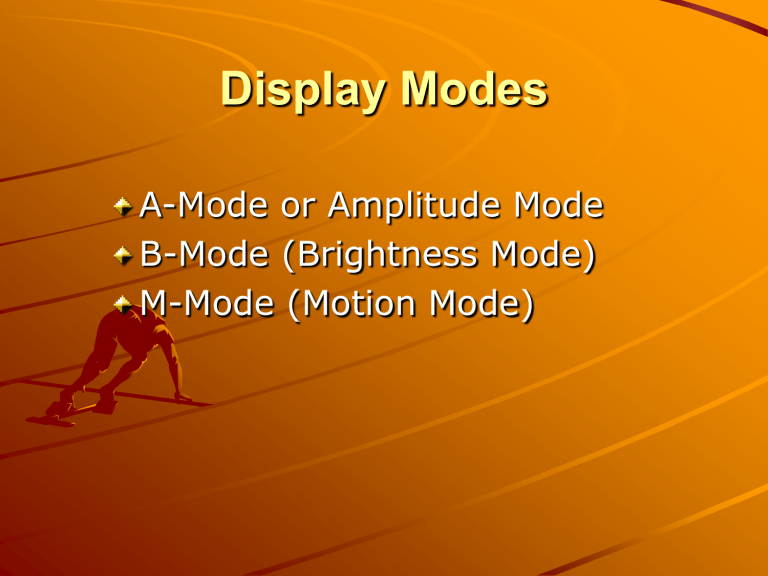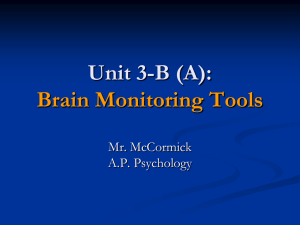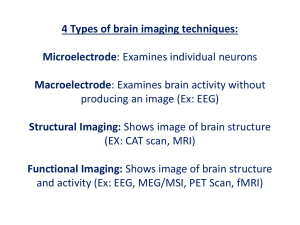Session 8 - Display Systems - my Tri

Display Modes
A-Mode or Amplitude Mode
B-Mode (Brightness Mode)
M-Mode (Motion Mode)
A-Mode
a one-dimensional display or image each pulse produces a new line of information on the display temporal resolution = PRP an uncommon display, except in ophthalmologic sonography used for precise intraocular length measurements
A-Mode
Height of the spike is proportional to the amplitude
A-Mode
Depth… horizontal axis corresponds to the reflector’s depth or distance
B-Mode (Brightness Mode)
- basis for gray scale,
two-dimensional (2D) imaging
US unit tracks the position of the transducer to place a dot on the screen corresponding to the transducer position (X, Y locations), creating a 2D image
B-Mode (Brightness Mode)
Each pulse from the transducer creates a single scan line from a series of returning echoes
A complete scan line resulting from one emitted pulse. occurs in < 1/1000 of a second (< 1 msec)
Scan Line
One pulse of ultrasound generates a single scan line (from a series of returning echoes).
A complete scan line resulting from one emitted pulse. This is accomplished in < 1/1000 of a second.
Echoes are presented in sequence on a scan line as they return from tissue.
(A) The first echo is displayed. (B) The second echo is added. (C) More echoes are added. (D) All the echoes from a single pulse have been received and displayed as a completed scan line.
2
3
4
0
1
B-Mode
A shade of gray is assigned to the amplitude of the echo
Stronger echo amplitude
= brighter dots
Vertical axis represents depth
M-Mode (Motion Mode)
- one-dimension image used to investigate moving structures with respect to time
Temporal resolution = PRP; each pulse produces a new line of echo information on the display evaluates motion pattern of moving structures such as in the heart
P
T
D
E
H
M Mode
A dot records echo position in relation to time
(horizontal axis) with the vertical axis representing depth
Echo amplitude is represented by the dot’s brightness
TIME >>>>
B Mode
M Mode
A Mode
Scanning Imaging
Static scanning (B scan)
Real-time
Static Scanning (B scan)
An articulated arm scanner scans the patient from many different directions creating a 2Dimage from multiple B-mode pulses
Multiple dots are combined to delineate the echo pattern of internal structures within the body
Superimposition of multiple scan lines creates a two-dimensional image that portrays the general contour of the patient and the internal organs
Compound B-mode scanning produces a static image that can be thought as a stop-action photograph of the reflecting surfaces
B Scan
B Scan
Static Scanner
B Scan
Real-time
Produces a video giving the impression of constant motion of the scanned anatomy
Consists of a series of frames displayed in rapid sequence creating the impression of constant motion
Provides rapid, convenient image acquisition with the display changing continuously as the scan plane is moved through the tissues
Real Time
Who’s that pregnant with twins??
A real time image before computer technology could handle increased lines/frame & faster frame rates.
How many shades of gray can you see?
Temporal Resolution
Resolution related to time & motion
Time from the beginning of one frame to the beginning of the next one (the time required to generate one complete frame)
Expressed in milliseconds (ms)
Ability to accurately determine the position of a structure at a particular instant in time
Depends on extent of movement of the structure & the frame rate
Important in imaging rapidly moving structures
Temporal Resolution
Each frame is made of many scan lines; when you # of scan lines - the frame rate
Improves as the frame rate increases (a greater # of frames/ second) because less time elapses from one frame to the next
Temporal Resolution
Depends upon 2 factors:
1.
# of images created/second (frame rate)
- higher frame rates (greater number of frames created/second), the better the temporal resolution. To temporal resolution, frame rate must be
2.
Higher frame rates are needed to evaluate motion or moving structures, such as adult, pediatric and fetal hearts
Spatial (detail) resolution
ability to see detail on the image affected by the # of scan lines & focuses
# of scan lines spatial resolution
More detail is needed to scan organs in the body so a slower frame rate is tolerated
When temporal resolution , spatial resolution !
Scanning Speed Limitation
Real-time scanning consists of multiple frames/second that are made up of multiple scan lines per frame
Its advantage is temporal resolution
To create each scan line, the ultrasound unit must wait until all echoes have been received from the selected depth before sending out the next pulse, if not range ambiguity occurs
Range Ambiguity
When structures beyond the indicated range are depicted in an image
Cause – time between the transmitted pulse & detected echo is not coreectly measured
Occurs when an echo (from the previous pulse) is received after the next pulse is transmitted
Scanning Speed Limitation
US unit can’t work any faster than the sound wave can travel, so propagation speed plays a major role in limiting the scanning speed
The # of focuses that the sonographer uses while imaging will slow down the process of obtaining a scan line
Imaging depth controls determine when the next pulse is sent out (PRF)
The # of foci used in imaging will slow down the process of obtaining a scan line
Imaging depth controls determine when the next pulse is sent out (PRF)
Frame Rate
# of frames/second (fps).
Human eye can see flickering (each individual frame being produced) at frame rates < 15 -20 fps
Acceptable frame rates are 30 fps-60 fps
Factors affecting frame rate are:
• depth of field
• # of lines used to create the image
• # of focal zones used
Sound travels 1,540 m/s (154,000 cm/s) in ST
A pulse can travel to & from a depth of 77,000 cm/s
Imaging with multi focus- and annular arrays
(multiple pulses to various depths to create a single composite scan line) requires even more time
Creating a single frame with a large # of scan lines requires TIME. Presenting many frames in rapid sequence requires TIME.
Frame Rate
To avoid misplacing the proper location from returning echoes on the display: imaging depth (cm) X lines/frame
X pulses/line [number of focal zones]
X frame rate 77,000 cm
Frame Rate
Consider the following scenario:
You are imaging a liver that extends to
10 cm deep with a 5.0 MHz probe. What is the maximum PRF permitted to avoid range ambiguity?
10 cm X 13 μs/cm = 130 μs - which means 1 pulse/130 μs
PRF = # pulses/sec = 1 pulse/130 μs = .0077 pulses/μs
7,700 pulses/sec = 7.7 KHz PRF = 7.7 KHz
Maximum Frame Rate
= c = PRF
2 X Distance X # lines/frame [lpf] lpf
= 7.7 KHz = 77 fps
100
Imaging depth
# of pulses (foci) per line lines per frame frame rate
ALL OF THE ABOVE battle over time
Therefore, a compromise to balance these factors must be based on meeting the clinical need.
PRF = # focuses X lines/frame X frame rate
PRF ↑ when you ↑ any of the following:
–# of focuses
–# of lines per frame
– frame rate
Consider this:
FRAME RATE ↓ with:
↑ # of focuses
↑ # of lines per frame
↑ in scanning penetration
Frame Rate
Solution depends on area of interest:
Imaging depth
Multiple focal zones
Line density
Frame rate
Imaging Depth
Complete depth that sound travels per pulse
Controlled by the sonographer to visualize the anatomy to be imaged that may lie superficially or deep in the body
The deeper the system images, the longer the listening time for each pulse
Deeper imaging results in:
longer listening time longer pulse repetition period lower PRF (# pulses/second) more time for each scan line
Multiple Focal Zones
US pulse has only a single focal zone
(region within the beam that provides the finest lateral resolution)
Using multiple sound beams with different focal depths to create a single image line, results in optimal lateral resolution all depths superior image quality
Multiple Focal Zones
A pulse is required for:
– each focus
– each scan line
– each frame
– More foci/image line = more pulses/image line
Multiple focal zones are controlled by the sonographer & are only used with phased array transducers (linear, curved, and annular)
More foci per image line result in:
more pulses/line superb lateral resolution at all depths more time/image scan line more time needed to create a frame
Line Density
# of scan lines that create a single image
Set automatically by the US system & is not controlled by the sonographer
The greater the line density, the more pulses/image sector
Increased Line Density results in:
greater detail within the image less “space” between image lines more sound pulses per image more time needed to create a frame
Line Density
For a sector scan: lines/degree
For a rectangular scan: lines/ cm
Frame Rate
determined by the US system & is not directly controlled by the sonographer when a rapidly moving structure is imaged at an unsuitably low frame rate, the images are said to ‘flicker’
More Frames per Second result in:
1.
greater accuracy in locating moving structures
2.
less time to make each frame
3.
decreased line density
THE DILEMMA
SO... to optimize these conditions: adjust the maximum imaging depth to the area of interest
Determine the # of foci per scan line.
Superior lateral resolution over a range of depths requires more foci. This determines the number of sound pulses required to make each scan line.
THEN…
The frame rate & line density are determined by the ultrasound system to balance the goals of temporal resolution (frame rate) & image quality (line density).
Deeper Imaging
Depth longer listening time longer pulse repetition period lower PRF (# of pulses/second)
Amount of time long
THE DILEMMA
Multiple Focal
Zones more sound pulses/line longer
T/R time superb lateral resolution at all depths more time per image scan line more time required for each scan line more time needed to create a frame
Amount of time long
Higher Line
Density greater spatial detail in the image
space between image lines
real detail more sound pulses/image
listening time more time needed to create a frame
Amount of time long
Higher Frame
Rate greater accuracy in locating moving structures
temporal resolution decreased line density; less detail resolution
Less imaging depth due to speed limitation less time allocated to make each frame/scan line
Amount of time short/frame; long with high frame rates
Recording Techniques
Before an image is recorded, the contrast
& brightness controls of the monitor are adjusted for optimal image quality
Contrast & brightness controls of the recording devices are then matched to the image on the monitor.
– Adjusting the contrast & brightness controls of the monitor without changing the contrast & brightness controls of the recording device, can lead to producing films that appear with increased gain or decreased gain, i.e., too light or too dark
Recording Devices
Hard copy film & paper
Thermal processors
Laser imaging systems
Digital recording devices videotape player
M-mode records
Magneto-optical (MO)
Picture Archiving & Communication
Systems
Teleradiology
Hard Copy Film and Paper
Transparent film uses a single emulsion film
Film is a cellulose acetate sheet coated with a gelatin emulsion containing silver bromide crystals
After exposure to light from the camera monitor, the film is developed in a chemical processor
Changes in the temperature of the chemicals will affect the quality of the film
Age & concentration of the chemicals can also affect the film
Thermal Processors
uses a paper medium to record the image less resolution & shades of gray than single emulsion film less archival stability
Color Thermal Printers
contain a ribbon of colored inks
(black, cyan, yellow, & magenta) printing on photo paper produces good quality color images used for color Doppler hard copy imaging
Laser Imaging Systems
capable of higher resolution, better gray scale uniformity & less image distortion
Initial cost outlay automated film handling & developing – saves sonographer processing time
15+ images available per sheet of film
Digital Recording Devices
- store the image on computer disks or in computer memories for viewing on monitors or later transfer to film
Videotape Player
used to record moving or real-time images record color as well as black & white images tapes store the image information on a magnetic medium
Follow recommended procedures when handling and storing tapes
Most common format is VHS
Super VHS (S-VHS) has better spatial resolution, less distortion & stores more information
Fiber optic recorder
(M-mode recorders)
paper developed by exposure to visible light dry silver paper as recording medium
-better gray scale
Trend
digital archiving & image storage
Magneto-optical (MO)
Magneto-optical (MO) is also known as optical technology. It is a combination of optical & magnetic technologies
Stores lots of information onto disk
(optical portion). MO drives can be rewritten and erased
Not susceptible to magnetic fields like regular diskettes or digital tapes so information storage is safe
Picture Archiving &
Communication Systems (PACS)
a computer network for the acquisition, display, & storage of images. provide for electronically communicating images to work stations, devices, and storage external to the instrument, the examining room,
& even the building where the scanning is done. protocols for communicating images and associated information between imaging devices and workstations have been standardized in the
Digital Imaging & Communications in Medicine
(DICOM) Standard
Picture Archiving &
Communication Systems (PACS)
Other names are digital imaging network
(DIN) & information management archiving and communications systems (IMACS)
Acquisition, display, hard copy, & computer components must be interconnected using a local area network (LAN)
Allows digitized images from multiple imaging modalities to be stored for later retrieval, display, manipulation & interpretation
Picture Archiving &
Communication Systems (PACS)
US scan data is digitized & transferred to the network. Standards for encoding patient file information developed by ACR
(American College of Radiology) & NEMA
(National Electrical Manufacturers Assoc.)
Provides for more centralized processing by reducing the need for multiple hard copy devices for each ultrasound or imaging modality system
Teleradiology
- is the electronic transfer of images from one location to another
Allows multiple hospitals to have quick access to images
Transmission methods include telephone lines, coaxial cables, fiber optic cables, microwave dishes, laser systems, satellites, & T-1 (multiple) telephone lines
Digital information is compressed and converted to transmission methods such as pulsed tone signals for sending over telephone lines






